团队内部冲突管理英文
冲突管理 英文版

12
Management, People & Organisations
Unitary and pluralistic frames of reference Unitary
One set of values, beliefs, commitments Shared understanding & commitment to objectives One source of leadership Team members - All pulling in the same direction Potential for harmony is assumed provided leader communicates well Disagreements è the result of misunderstanding Dissidents – the "rabble" hypothesis
Chris Jarvis
9
Management, People & Organisations
Stoking the fires
Doing things "by the book" Poor or dysfunctional communication Picking flights Sabotage & spoiling tactics Disregarding alienation & isolation Public (ritual) humiliation Highlighting faults & failures of others
Anne Mayden Nicoreta et al 1995
管理学专业术语(中英文对照)
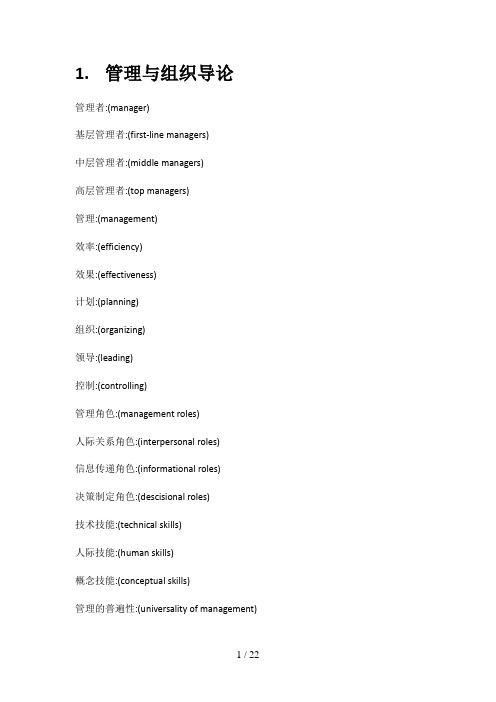
1.管理与组织导论管理者:(manager)基层管理者:(first-line managers)中层管理者:(middle managers)高层管理者:(top managers)管理:(management)效率:(efficiency)效果:(effectiveness)计划:(planning)组织:(organizing)领导:(leading)控制:(controlling)管理角色:(management roles)人际关系角色:(interpersonal roles)信息传递角色:(informational roles)决策制定角色:(descisional roles)技术技能:(technical skills)人际技能:(human skills)概念技能:(conceptual skills)管理的普遍性:(universality of management)2.管理的历史劳动分工:(division of labor)工作专业化:(job specialization)工业革命:(industrific revolution)科学管理:(scientific management)一般行政管理理论:(general administrative theory) 管理原则:(principles of management)官僚行政组织:(bureaucracy)定量方法:(quantitative approach)组织行为:(organizational behavior)霍桑研究系统:(Hawthorne studies systems)封闭系统:(closed systems)开放系统:(open systems)权变理论:(contingency approach)劳动力多元化:(workforce diversity)电子企业:(e-business)电子商务:(e-commerce)内部网:(intranet)学习型组织:(learning organization)知识管理:(knowledge management)质量管理:(quality management)3.组织文化与环境管理万能论:(omnipotent view of management) 管理象征论:(symbolil view of management)组织文化:(organization culture)强文化:(strong cultures)社会化:(socialization)工作场所精神境界:(workplace spirituality)外部环境:(external environment)具体环境:(specific environment)一般环境:(general environment)环境的不确定性:(environment uncertainty)环境的复杂性:(environment complexity)利益相关群体:(stakholders)4.全球环境中的管理狭隘主义:(parochialism)民族中心论:(ethnocentric attitude)多国中心论:(polycentric attitude)全球中心论:(geocentric attitude)跨国公司:(multinational corporation)多国公司:(multidomestic corporation)全球公司:(global company)跨国或无边界组织:(transnational or boredrless organization) 初始全球化组织:(born globals)全球外购:(global sourcing)出口:(exporting)进口:(importing)许可证经营:(licensing)许可经营:(franchising)战略同盟:(strategic alliance)合资企业:(joint venture)外国子公司:(foreign subsidiary)市场经济:(market economy)计划经济:(command economy)民族文化:(national culture)5.社会责任与管理道德古典观点:(classical view)社会经济学观点:(socioeconomic view)社会义务:(social obligation)社会响应:(social responsiveness)社会责任:(social responsinility)社会屏障筛选:(social screening)管理的绿色化:(gerrning of management)以价值观为基础的管理:(values-based management) 道德:(ethics)自我强度控制点:(ego strength locus of control)道德准则:(code of ethics)社会企业家:(social entrepreneur)社会影响管理:(social impact management)6.制定决策决策:(decisions)决策制定过程:(decision-making process)决策标准问题:(decision criteria problem)理性的:(rational)有限理性:(bounded rationality)满意的承诺升级:(satisfied escalation of commitment) 直觉决策:(intuitive decision making)结构良好问题:(structured problems)程序化决策:(programmed decision)程序:(procedure)规则:(rule)政策:(policy)结构不良问题:(unstructured problems)非程序化决策:(nonprogrammed decisions) 确定性:(certainty)风险性:(risk)命令型风格:(directive style)分析型风格:(analytic style)概念型风格:(conceptual style)行为型风格:(behavioral style)启发法:(heuristics)7.计划的基础陈述目标:(stated goals)真实目标:(real goals)战略计划:(strategic plans)运营计划:(operational plans)长期计划:(long-term plans)短期计划:(short-term plans)具体计划:(specific plans)方向性计划:(directional plans)一次性计划:(single-used plans)持续性计划:(standing plans)传统目标:(traditional goal setting)手段-目标链:(means-ends chain)目标管理:(management by objectives)使命:(mission)承诺概念:(commitment concept)正式计划部门:(formal planning department) 8.战略管理战略管理:(strategic management)组织战略商业模式:(strategies business model ) 战略管理过程:(strategic management process) 机会:(opportunities)威胁:(threats)资源:(resources)能力:(capabilities)核心竞争力:(core competencies)SWOT分析法:(SWOT analysis)公司层战略:(corporate strategy)增长战略:(growth strategy)相关多元化:(related diversification)非相关多元化:(unrelated diversification) 稳定性战略:(stability strategy)更新战略:(renewal strategies)紧缩战略:(retrenchment strategy)扭转战略:(turnaround strategy)BCG矩阵:(BCG matrix)业务层战略:(business strategy)战略业务单元:(strategic business units) 竞争优势:(competitive advantage)成本领先战略:(cost leadership strategy) 遵循差异化战略:(differentiation strategy) 聚焦战略:(focus strategy)徘徊其间:(stuck in the middle)战略灵活性:(strategic flexibility)市场先入者:(first mover)9.计划的工具技术环境扫描:(environment scanning)竞争对手情报:(competitor intelligence) 预测:(forecasts)定量预测:(quantitative forecasting)定性预测:(qualitative forecasting)标杆比较:(benchmarking)资源:(resources)预算:(budget)甘特图:(Gantt chart)负荷图:(load chart)事件:(events)计划评审技术:(the program evaluation and review technique) 活动:(activities)松弛时间:(slack time)关键路径:(critical path)盈亏平衡分析:(breakeven analysis)线性规划:(linear programming)项目管理:(project management)脚本:(scenario)10.组织结构与设计组织结构设计:(organazational structure design)工作专门化:(work specialization)职能部门化:(functional departmentalization)产品部门化:(product departmentalization)地区部门化:(geographical departmentalization) 过程部门化:(process departmentalization)顾客部门化:(customer departmentalization)跨职能团队:(cross-functional teams)指挥链:(chain of command)职权:(authority)职责:(responsibility)统一指挥:(unity of command)管理跨度:(span of control)集权化:(centralization)分权化:(decentralization)员工授权:(employee empowerment)正规化:(formalization)机械式组织:(mechanistic organization)有机式组织:(organic organization)单件生产:(unit production)大批量生产:(mass production)连续生产:(process production)简单结构:(simple structure)职能型结构:(flanctional structure)事业部型结构:(divisional structure)团队结构:(team structure)矩阵型结构:(matrix structure)项目型结构:(project structure)无边界组织:(boundaryless organization) 虚拟组织:(virtual organization)学习型组织:(learning organization)组织结构图:(organizational charts) 11.沟通与信息技术沟通:(communication)人际沟通:(interpersonal communication) 组织沟通:(organizational communication) 信息:(message)编码:(encoding)解码:(decoding)沟通过程:(communication process)噪声:(noise)非语言沟通:(nonverbal communication) 体态语言:(body language)语调:(verbal intonation)过滤:(filtering)信息超载:(information overload)积极倾听:(active listening)正式沟通:(formal communication)非正式沟通:(informal communication)下行沟通:(upward communication)横向沟通:(lateral communication)斜向沟通:(diagonal communication)沟通网络:( communication networks)小道消息:(grape-vine)电子邮件:(e-mail)即时消息:(instant messaging)音频邮件:(voice-mail)电子数据交换:(electrinic data interchange) 电话会议:(teleconferencing)可视会议:(videoconferencing)网络会议:(webconferencing)内部互联网:(intranet)外部互联网:(Extranet)实践社区:(communities practive)12.人力资源管理高绩效工作实务:(high-performance work practices)人力资源管理过程:(human resource management process) 工会(labor union)反优先雇佣行动计划:(affirmative action)人力资源规划:(human resource planning)职务分析:(job analysis)职务说明书:(job description)职务规范:(job specification)招聘:(recruitment)解聘:(decriuitment)甄选:(selection)效度:(validity)信度:(reliability)工作抽样:(work samping)评估中心:(assessment centers)真实工作预览:(relistic job preview)上岗培训:(orientation)绩效管理系统:(performance management system)书面描述法:(written essay)关键事件法:(critical incidents)评分表法:(graphic rating scales)行为定位评分法:(behaviorally anchored rating scales) 多人比较法:(multiperson comparisons)360度反馈法:(360-degree feedback)基于技能薪酬:(skill-based pay)浮动工资:(variable pay)精简机构:(downsizing)性骚扰:(sexual harassment)基于家庭的福利:(family-friendly benefits)13.变革与创新管理组织变革:(organizational change)变革推动者:(change agent)组织发展:(organizational development)压力:(stress)14.行为的基础行为:(behavior)组织行为学:(organizational behavior)员工生产率:(employee productivity)离职率:(turnover)组织公民行为:(organizational citizen behavior)工作满意度:(job satisfaction)工作场所不当行为态度:(workplace misbehavior attitudes) 认知行为:(cognitive component)情感成分:(affective component)行为成分:(behavior component)组织承诺:(organizational commitment)组织支持感:(perceived organizational support)认知失调:(cognitive dissonance)态度调查:(attitude surveys)人格:(personality)马基雅维里主义:(machiavellianism)自尊:(self-esteem)自我控制:(self-monitoring)印象管理:(impression management)情绪:(emotion)情绪智力:(emotional Intelligence)知觉:(perception)归因理论:(attribution theory)基本归因错误:(fundamental attribution error)自我服务偏见:(self-serving bias)假设相似性:(assumed similarity)刻板印象:(stereotyping)晕轮效应:(halo effect)操作性条件反射:(operant conditioning)社会学习理论:(social learning theory)行为塑造:(shaping behavior)15.理解群体与团队群体:(group)形成阶段:(forming)震荡阶段:(storming)规范阶段:(norming)执行阶段:(performing)解体阶段:(adjourning)群体思维:(groupthink)地位:(status)社会惰化:(social loafing)群体内聚力:(group cohesiveness)冲突:(conflict)冲突的传统观点:(traditional view of conflict)冲突的人际关系观点:(human relations view of conflict)冲突的交互作用观点:(interactionist view of conflict) 积极冲突:(functional conflict)消极冲突:(disfunctional conflict)任务冲突:(task conflict)关系冲突:(relationship conflict)过程冲突:(process conflict)工作团队:(workteams)自我管理团队:(self-managed work teams)跨职能团队:(cross-functional team)虚拟团队:(virtual team)社会网络构造:(social network structure)16.激励员工动机:(motivation)需要层次理论:(hierarchy of needs theory)双因素理论:(two-factor theory)保健因素:(hygiene factors)激励因素:(motivators)三种需要理论:(three-needs theory)成就需要:(need for achievement)权力需要:(need for power)归属需要:(need for affiliation)目标设置理论:(goal-setting theory)自我效能感:(self-efficacy)强化理论:(reinforcement theory)强化物:(reinforcer)工作设计:(job design)工作扩大化:(job enlargement)工作丰富化:(job enrichment)工作深度:(job depth)工作特征模型:(job characteristics model) 公平理论:(equity theory)参照对象:(referents)分配公平:(distributive justice)程序公平:(procedural justice)期望理论:(expectancy theory)压缩工作周:(compressed workweek)弹性工作制:(flexible work hours)弹性时间制:(flextime)工作分担:(job sharing)远程办公:(telecommuting)账目公开管理:(open-book management)员工认可方案:(employee recognition programs)绩效工资方案:(pay-for-performance program)股票期权:(stock options)17.领导领导者:(leader)领导:(leadership)行为理论:(behavioral theories)独裁型风格:(authoeratic style)民主型风格:(democratic style)放任型风格:(laissez-faire style)定规维度:(initiating strueture)关怀维度:(consideration)高-高型领导者:(high-high leader)管理方格:(managerial grid)权变模型:(contingency model)最难共事着问卷:(least-preferred co-worker questionnaire) 情境领导理论:(situational leadership theory)成熟度:(readiness)领导者参与模型:(leader participation model)路径-目标理论:(path-goal theory)交易型领导者:(transactional leaders)变革型领导者:(transformational leaders) 领袖魅力型领导者:(charismatic leader) 愿景规划型领导:(visionary leadership) 法定权利:(legitimate power)强制权利:(coercive power)奖赏权力:(reward power)专家权利:(expert power)参照权利:(referent power)信誉:(credibility)信任:(trust)授权:(empowerment)18.控制的基础控制:(controlling)市场控制:(market control)官僚控制:(bureaucratic control)小集团控制:(clan control)控制过程:(control process)偏差范围:(range of variation)直接纠正行动:(immediate corrective)彻底纠正行动:(basic correvtive action)绩效:(performance)组织绩效:(organizational performance)生产率:(productivity)组织有效性:(organizational effectiveness)前馈控制:(feedforward control)同期控制:(concurrent control)走动管理:(management by walking around)反馈控制:(feedback control)经济附加值:(economic value added)市场附加值:(market valueadded)平衡计分卡:(balanced scorecard)管理信息系统:(management information system) 标杆比较:(benchmarking)员工偷窃:(employee theft)服务利润链:(service profit chain)公司治理:(corporate governance)19.运营与价值链管理运营管理:(operations management)制造型组织:(manufacturing organizations)服务型组织:(service organizations)价值链:(value chain)价值链管理:(value chain management) 组织过程:(organizational processes)知识产权:(intellectual processes)质量:(quality)批量定制:(mass customization)。
冲突管理(ConflictManagement)
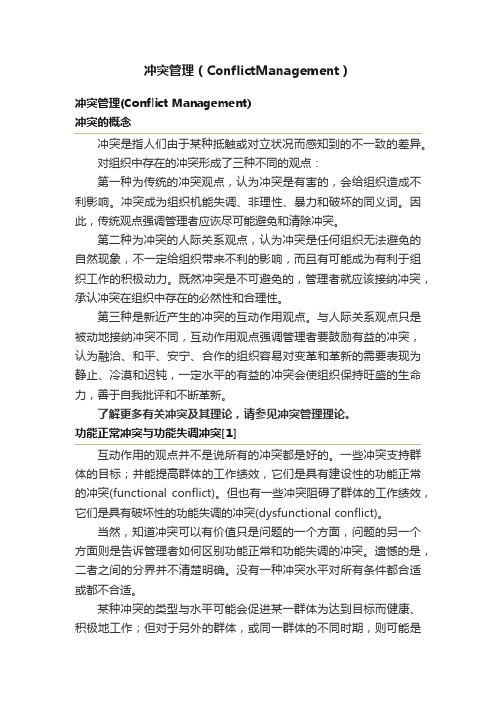
冲突管理(ConflictManagement)冲突管理(Conflict Management)冲突的概念冲突是指人们由于某种抵触或对立状况而感知到的不一致的差异。
对组织中存在的冲突形成了三种不同的观点:第一种为传统的冲突观点,认为冲突是有害的,会给组织造成不利影响。
冲突成为组织机能失调、非理性、暴力和破坏的同义词。
因此,传统观点强调管理者应诙尽可能避免和清除冲突。
第二种为冲突的人际关系观点,认为冲突是任何组织无法避免的自然现象,不一定给组织带来不利的影响,而且有可能成为有利于组织工作的积极动力。
既然冲突是不可避免的,管理者就应该接纳冲突,承认冲突在组织中存在的必然性和合理性。
第三种是新近产生的冲突的互动作用观点。
与人际关系观点只是被动地接纳冲突不同,互动作用观点强调管理者要鼓励有益的冲突,认为融洽、和平、安宁、合作的组织容易对变革和革新的需要表现为静止、冷漠和迟钝,一定水平的有益的冲突会使组织保持旺盛的生命力,善于自我批评和不断革新。
了解更多有关冲突及其理论,请参见冲突管理理论。
功能正常冲突与功能失调冲突[1]互动作用的观点并不是说所有的冲突都是好的。
一些冲突支持群体的目标;并能提高群体的工作绩效,它们是具有建设性的功能正常的冲突(functional conflict)。
但也有一些冲突阻碍了群体的工作绩效,它们是具有破坏性的功能失调的冲突(dysfunctional conflict)。
当然,知道冲突可以有价值只是问题的一个方面,问题的另一个方面则是告诉管理者如何区别功能正常和功能失调的冲突。
遗憾的是,二者之间的分界并不清楚明确。
没有一种冲突水平对所有条件都合适或都不合适。
某种冲突的类型与水平可能会促进某一群体为达到目标而健康、积极地工作;但对于另外的群体,或同一群体的不同时期,则可能是功能失调的冲突。
区分冲突是功能正常的还是功能失调的指标是群体的工作绩效。
群体之所以存在是为了达到一定的目标。
管理冲突(英文)
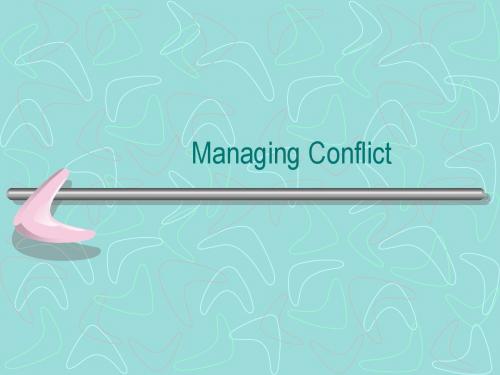
A Process Model of Conflict
1. Latent Conflicts: These are the underlying causes of conflict situations.
• Functional interdependence • Allocational interdependence
What is Conflict?
• Three definitions: 1. Two systems (persons, groups, firms, nations) are in conflict when they interact directly in such a way that the actions of one tend to prevent or compel some outcome against the resistance of the other.
– Conflict requires that managers analyze their goals. – Conflict creates dialog among employees. – Conflict fosters creative solutions.
• Without conflict, firms would stagnate.
Two Explanations for the Felt Component in Conflicts
2. An employee may become personally involved with the firm. Their self-image may rely on job successes or failures. Felt conflict may be shown through fear, threat, mistrust, and hostility. Use nondefensive communication when managing felt conflict.
处理团队冲突英文作文
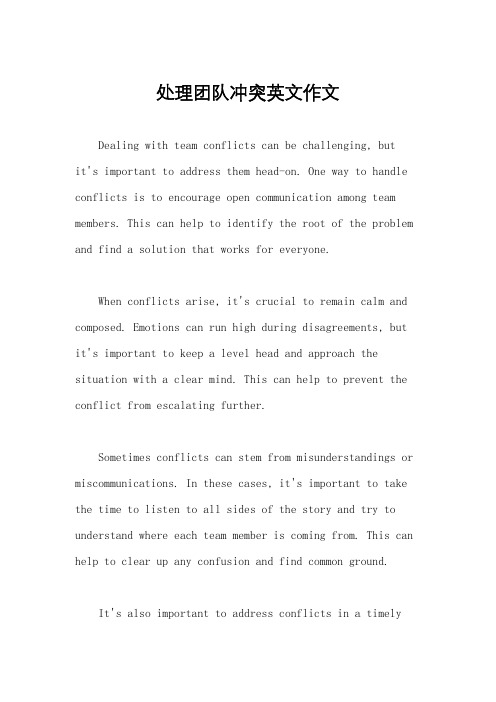
处理团队冲突英文作文Dealing with team conflicts can be challenging, butit's important to address them head-on. One way to handle conflicts is to encourage open communication among team members. This can help to identify the root of the problem and find a solution that works for everyone.When conflicts arise, it's crucial to remain calm and composed. Emotions can run high during disagreements, but it's important to keep a level head and approach the situation with a clear mind. This can help to prevent the conflict from escalating further.Sometimes conflicts can stem from misunderstandings or miscommunications. In these cases, it's important to take the time to listen to all sides of the story and try to understand where each team member is coming from. This can help to clear up any confusion and find common ground.It's also important to address conflicts in a timelymanner. Ignoring or avoiding the issue can make it worse in the long run. By addressing conflicts promptly, you can prevent them from festering and causing more damage to the team dynamic.In some cases, it may be necessary to bring in aneutral third party to help mediate the conflict. Thiscould be a team leader, manager, or HR representative. Having an impartial mediator can help to facilitate a productive discussion and find a resolution that is fair to all parties involved.Ultimately, resolving conflicts within a team requires patience, understanding, and a willingness to work together towards a solution. By approaching conflicts with apositive attitude and a commitment to finding common ground, teams can overcome challenges and strengthen their relationships in the process.。
团队内部冲突管理-实用PPT

TEAMWORK & TEAM-BUILDING ELEMENTS
3. Decide how to bring the hidden agenda to light.
TEAMWORK & TEAM-BUILDING ELEMENTS
1. A team is composed of two or more persons in the company, usually from different departments.
HOW CAN LEADERS MAKE A TEAM MORE EFFECTIVE?
3. Never change your mind just to avoid an argument. Encourage different opinions among team members.
4. If an agreement comes too quickly, take another look at the issue.
HOW CAN LEADERS MAKE A TEAM MORE EFFECTIVE?
7. Make sure that every member of the group contributes.
Making the transition to teams means a fundamental shift in power and authority. Managers must get used to being coaches who liberate.
如何解决管理者和员工间的矛盾?(英语版)
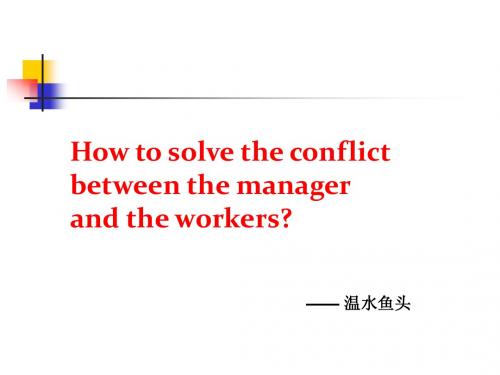
—— 温水鱼头
cause
1、overtime scheduling 超时
2、Workers do not want to be locked into a spur-ofthe-moment overtime assignment 员工不愿意做未经过仔细考虑的超时工作
(3)The workers receive manager’s reasonable request 工人们接受经理的合理要求 If they have got what they want, less problems are better for them.
3、Invent options for mutual gains创造可选择的共 同利益
2、Separate the people from the problem 针对问题不针对人
(1)Manager should avoid quarrelling with the workers 避免和员工争吵 (2)Manager should be better communication with the workers和 员工好好沟通 Manager should communicate with workers to know more about their feelings .Then choose one opinion to come to an agreement .
(1)Add the payment 提高工资 Manager can give the workers pay for the overtime. The payment is the same as workers’ daily wages or more than the normal. (2)Employ more workers 扩招员工 Manager can employ more workers ,arrange these workers into two groups ,one for the daytime and one for the night time ,so the warehouse will be fully staffed.
团队内部冲突管理(英文)

HIDDEN AGENDA ISSUES
❖ Hidden agendas:
Comprised of attitudes and feelings that an individual brings to the group. Hidden agendas represent what an individual or group wants, instead of what they say they want.
2. The members are competent and knowledgeable in the way they carry out their duties.
TEAMWORK & TEAM-BUILDING ELEMENTS
3. The team is constantly learning and growing; adapting itself to changing requirements and multiple goals.
❖ Conformity:
Group pressure forces its members to conform, or comply, with the norms established by the group.
CHARACTERISTICS OF S
❖ Cohesiveness:
An emotional closeness that exists among the group members, and its success depends on how well the group sticks together and acts as a single unit instead of as a group of individuals.
组织行为学中英文词汇对照

组织行为学中英文词汇对照Aability[ə'bɪləti]能力achievement[ə'tʃivmənt]成就动机achievement need成就需要affiliation need[ə,fɪlɪ'eʃən]归属需要arbitrator['ɑːbɪtreɪtə]仲裁人assessment centers[ə'sɛsmənt]['sɛntɚz]评价中心attitude['ætɪtʊd]态度attribution归因attribution theory归因理论attribution theory of leadership领导的归因理论Bbehavioral theories of leadership领导的行为理论behaviorism theories行为主义理论Big Five personality traits"大五"人格特质body language身体语言bounded rationally有限理性brainstorming脑力激荡法bureaucracy官僚结构Ccareer职业centralization集权化chain of command命令链charismatic leadership领袖魅力的领导charismatic leadership theories魅力领导理论classical conditioning经典条件反射cliques小集团cognitive component of an attitude态度的认知成分cognitive learning认知学习cognitive theories认知理论cohesiveness凝聚力collaborating协作command group命令型群体communication沟通communication apprehension沟通焦虑communication networks沟通网络communication process沟通过程competence能力competing竞争compromising折中conciliator和解人conflict冲突conflict management冲突管理conflict process冲突过程conformity从众问题conscientiousness责任心consideration关怀维度consistency一贯contingency approaches to management管理的权变途径contingency leadership theory领导权变理论continuous reinforcement连续强化contrast effects对比效应control theory控制理论controlling控制core values核心价值观creativity创造力cross-functional teams多功能型团队cultural differences文化差异Ddecision making决策decision rationality决策理性decision role决策角色decision-making style决策风格decisions决策decoding解码delegating style授权风格Delphi technique德尔菲技术Departmentalization部门化dispositional attributions个性归因distributive bargaining分配谈判distributive justice分配公平diversity多元化dominant culture主导文化downward communication下行沟通Dynamics of Synergy协力优势dysfunctional conflict功能失调的冲突Eeconomic rationality model经济理性模型emotion情绪emotional intelligence情绪智力emotional stability情绪稳定性mployee involvement员工参与employee-oriented leader员工导向的领导者empowerment授权encoding编码encounter stage碰撞阶段engagement卷入environment环境equity theory公平理论equity theory of work motivation工作动机的公平理论ERG theory ERG理论exchange leadership theories领导的交换理论expectancy theory期望理论export power专家性权力external validity外部效度externals外控者extraversion外向性extrinsic motive外源性动机extrinsic rewards外部报酬Ffeedback反馈Fiedler contingency model费德勒的权变模型filtering过滤Five-Factor Model(FFM)五因素模型flexible benefits灵活福利formal group正式群体formal networks正式沟通网络formal organization正式组织function conflict功能正常的冲突functional analysis功能性分析fundamental attribution error基本归因偏差Ggeneral mental ability(GMA)一般心理能力goal conflict目标冲突goal setting目标设定goal sharing目标共享goal-setting theory目标设置理论group群体group decision making群体决策group leadership theories领导的群体理论group stressors群体压力源group shift群体转移groupthink群体思维Hhalo effect晕轮效应Hawthorne effect霍桑效应Herzberg's Two-Factor Theory of Motivation赫茨伯格的动机双因素理论horizontal organization扁平化组织human capital人力资本human relations views of conflict冲突的人际关系观点hygiene factors保健因素Iincentives诱因informal groups非正式群体informal network非正式沟通网络information richness信息丰富性initiating structure结构维度instrumental values工具价值观integrative bargaining综合谈判intergroup dynamics组间动力integrity正直intellectual ability心理能力intelligence activity智力活动interacting groups互动群体interactional view of conflict冲突的相互作用观点interest group利益型群体internal validity内部效度internals内控者interpersonal communication人际沟通interpersonal roles人际角色intrinsic motive内源性动机intrinsic rewards内部报酬intuition直觉Jjob design工作设计job enlargement工作扩大化job enrichment工作丰富化job involvement工作参与job rotation工作轮换job satisfaction工作满意度job specification工作规范Kknowledge management知识管理Lleader role领导角色leader-member exchange(LMX)theory领导者—成员交换理论leader-member relations领导者—成员关系leadership领导eadership skill领导技能learned helplessness习得性无助learning学习learning organization学习型组织least preferred coworker(LPC)questionnaire最难共事者问卷life-cycle approach生命周期理论lower-order needs较低层次的需要loyalty忠诚Mmanagement by objectives(MBO)目标管理Management Information System(MIS)管理信息系统managerial communication model管理沟通模型managerial grid管理方格论managerial grid style管理方格风格managers管理者Maslow's hierarchy of needs马斯洛的需要层次理论means-ends chain途径—目标链monitor监控者mood心情motivation激励multicultural organization多元文化型组织Nneed需要negative reinforcement负性强化neglect忽略negotiation谈判negotiation skills谈判技巧nominal group technique名义群体技术nonverbal communication非语言沟通normative commitment规范承诺norms规范Ooperant conditioning操作条件反射organization组织organizational behavior(OB)组织行为学Organizational Citizenship Behaviors(OCBs)组织的公民行为organizational commitment组织承诺organizational culture组织文化organizational development组织发展Organizational Hierarchies组织层级organizational structure组织结构Pparticipating style参与风格participative management参与式管理path-goal leadership theory路径—目标领导理论pay for performance绩效奖金perception知觉perceptual context知觉背景personality人格personality traits人格特质Porter Lawler motivation model波特—劳勒动机模型position power职位权力positive reinforcement正性强化power权力power motive权力动机power need权力需要problem-solving teams问题解决型团队production-oriented leader生产导向的领导者productivity生产率profit sharing利润共享projection投射psychological contract心理契约Qquality of life生活质量quality of work life(QWL)工作生活质量Rrationality理性recognition认可reengineering再造工程reinforcement theory强化理论reinforcers强化物risky shift phenomenon风险偏移现象role角色role ambiguity角色模糊role conflict角色冲突role expectations角色期待role identity角色同一性role perception角色知觉Ssecurity motive安全动机selective perception选择性知觉self-actualization自我实现self-esteem自尊self-managed teams自我管理团队selling style推销风格sensitivity training敏感性训练similarity相似性Simmon's Bounded Rationality Model西蒙的有限理性模型situational attributions情景归因situational leadership情境领导理论small groups小群体social cognition theory社会认知理论social learning社会学习social loafing社会惰化social perception社会知觉social recognition社会认可socialization process社会化过程social-learning theory社会学习理论status地位status motive地位动机stereotyping刻板印象storming震荡stress压力strong culture强文化subculture亚文化synergy协同效应Ttask group任务型群体task structure任务结构team团队team building团队建设team structure团队结构terminal values终极价值观Thematic Apperception Test(TAT)主题统觉测验theory X X理论theory Y Y理论traditional view of conflict冲突的传统观点trait theories of leadership领导的特质理论transactional leadership交易型领导者transformational leadership 变革型领导者trust信任turnover流动type A personality A型人格Uupward communication上行沟通Vvalues价值观virtual organization虚拟组织virtual teams虚拟团队Wwork group工作群体work specialization工作专门化专业词汇(葡语)1.desejos愿望2.valores opostos,相反的价值观3.Diferentes sistemas de valores不同的价值体系4.negativamente afetado负面影响5.tem que ser percebido被感知6.forma de oposição反对的形式7.solução ganho-ganho双赢的方案8.interesses利益。
冲突管理(英文讲义)
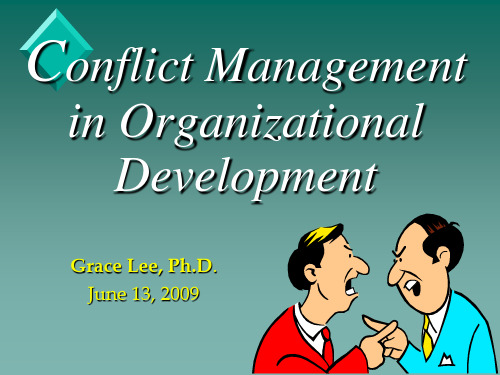
Conflict Management Styles
Compromising:
give up some ideas and demand that others do the same –Look for “common ground”
Compromise.
–A strategy for finding an expedient solution. –Resolution is mutually acceptable for all parties. A temporary settlement for complex issues. Group goals outweigh assertive strategies. Individuals of equal status are equally committed. –Compromise works towards partially satisfying both parties, but each party must honor the resolution for continued satisfaction.
Avoidance.
–Most preferred strategy during initial stages. –Individuals fail to address the conflict. Nothing to lose. Lack of time. Inappropriate time or place. Individuals are angry. Emotional involvement. –Postponing a resolution hinders group progress.
团队中的冲突与合作英语作文
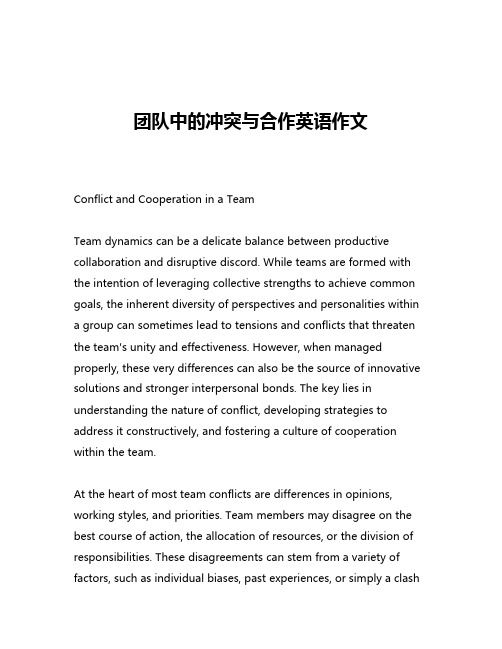
团队中的冲突与合作英语作文Conflict and Cooperation in a TeamTeam dynamics can be a delicate balance between productive collaboration and disruptive discord. While teams are formed with the intention of leveraging collective strengths to achieve common goals, the inherent diversity of perspectives and personalities within a group can sometimes lead to tensions and conflicts that threaten the team's unity and effectiveness. However, when managed properly, these very differences can also be the source of innovative solutions and stronger interpersonal bonds. The key lies in understanding the nature of conflict, developing strategies to address it constructively, and fostering a culture of cooperation within the team.At the heart of most team conflicts are differences in opinions, working styles, and priorities. Team members may disagree on the best course of action, the allocation of resources, or the division of responsibilities. These disagreements can stem from a variety of factors, such as individual biases, past experiences, or simply a clashof personalities. If left unresolved, these conflicts can escalate into more serious issues, undermining the team's morale, productivity, and overall effectiveness.However, it is important to recognize that conflict is not inherently negative. In fact, a certain level of constructive conflict can be beneficial for a team's growth and development. When team members are willing to challenge each other's ideas and engage in healthy debates, it can lead to more thorough analysis, innovative thinking, and ultimately, better decision-making. The key is to ensure that these conflicts remain focused on the task at hand and do not devolve into personal attacks or unproductive power struggles.To navigate team conflicts effectively, it is crucial for team members to develop strong communication and conflict resolution skills. This includes the ability to actively listen to others, express one's own perspectives clearly and respectfully, and seek common ground through compromise and consensus-building. Team leaders can also play a vital role in setting the tone for how conflicts are addressed, by modeling constructive behavior and encouraging a culture of open and honest dialogue.In addition to effective communication, cooperation is another essential element in building a successful team. Cooperation involves a willingness to work together, share resources, and support oneanother towards a common goal. This can be fostered through team-building activities, shared decision-making processes, and a focus on collective achievements rather than individual successes.One effective strategy for promoting cooperation within a team is to emphasize the interdependence of team members. By highlighting how each individual's contributions are essential to the team's overall success, team members are more likely to recognize the value of collaboration and be motivated to work together towards a shared objective. This can be particularly important in complex or time-sensitive projects, where the successful completion of the task relies on the seamless integration of various skills and expertise.Another key aspect of fostering cooperation is to encourage a spirit of mutual respect and trust within the team. When team members feel valued, heard, and supported by their colleagues, they are more likely to be open to compromise, willing to take risks, and committed to the team's success. This can be achieved through regular feedback, recognition of individual strengths, and a commitment to addressing any issues or concerns that may arise.Ultimately, the ability to navigate team conflicts and promote cooperation is a critical skill for any team member or leader. By understanding the nature of conflict, developing effective communication strategies, and cultivating a culture of collaboration,teams can harness the power of their diversity to achieve remarkable results. Whether tackling complex challenges or striving for innovative breakthroughs, the ability to work together effectively can be the difference between success and failure.。
冲突管理理论
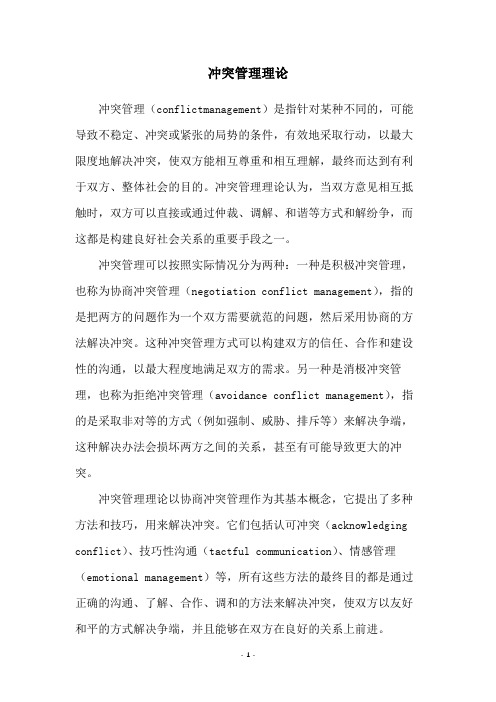
冲突管理理论冲突管理(conflictmanagement)是指针对某种不同的,可能导致不稳定、冲突或紧张的局势的条件,有效地采取行动,以最大限度地解决冲突,使双方能相互尊重和相互理解,最终而达到有利于双方、整体社会的目的。
冲突管理理论认为,当双方意见相互抵触时,双方可以直接或通过仲裁、调解、和谐等方式和解纷争,而这都是构建良好社会关系的重要手段之一。
冲突管理可以按照实际情况分为两种:一种是积极冲突管理,也称为协商冲突管理(negotiation conflict management),指的是把两方的问题作为一个双方需要就范的问题,然后采用协商的方法解决冲突。
这种冲突管理方式可以构建双方的信任、合作和建设性的沟通,以最大程度地满足双方的需求。
另一种是消极冲突管理,也称为拒绝冲突管理(avoidance conflict management),指的是采取非对等的方式(例如强制、威胁、排斥等)来解决争端,这种解决办法会损坏两方之间的关系,甚至有可能导致更大的冲突。
冲突管理理论以协商冲突管理作为其基本概念,它提出了多种方法和技巧,用来解决冲突。
它们包括认可冲突(acknowledging conflict)、技巧性沟通(tactful communication)、情感管理(emotional management)等,所有这些方法的最终目的都是通过正确的沟通、了解、合作、调和的方法来解决冲突,使双方以友好和平的方式解决争端,并且能够在双方在良好的关系上前进。
冲突管理理论不仅可以用来促进双方建立良好的关系,它还可以帮助双方更好地理解对方的观点和情况,因而更好地解决双方的冲突,真正建立起信任、友好和相互理解的关系。
它同样可以作为关系的重要组成部分,可以提高双方的关系质量,从而促进和平、稳定、协调的社会发展。
因此,冲突管理理论的重要性已经不容忽视。
双方应该深入研究冲突管理理论,在处理冲突时更加清晰地明白双方的需求,以便更有效地解决冲突,实现双方共赢局面,创造一个良好的社会环境。
组织行为学中英文词汇对照

组织行为学中英文词汇对照以下是为大家整理的组织行为学中英文词汇对照的相关范文,本文关键词为组织,行为学,中英文,词汇,对照,组织,行为学,中英文,词汇,您可以从右上方搜索框检索更多相关文章,如果您觉得有用,请继续关注我们并推荐给您的好友,您可以在英语学习中查看更多范文。
组织行为学中英文词汇对照Aability[?\'b?l?ti]能力achievement[?\'t?ivm?nt]成就动机achievementneed成就需要affiliationneed[?,f?l?\'e??n]归属需要arbitrator[\'ɑ?b?tre?t?]仲裁人assessmentcenters[?\'s?sm?nt][\'s?nt?z]评价中心attitude[\'?t?t?d]态度attribution归因attributiontheory归因理论attributiontheoryofleadership领导的归因理论bbehavioraltheoriesofleadership领导的行为理论behaviorismtheories行为主义理论bigFivepersonalitytraits大五人格特质bodylanguage身体语言boundedrationally有限理性brainstorming 脑力激荡法bureaucracy官僚结构ccareer职业centralization集权化chainofcommand命令链charismaticleadership领袖魅力的领导charismaticleadershiptheories魅力领导理论classicalconditioning经典条件反射cliques小集团cognitivecomponentofanattitude态度的认知成分cognitivelearning 认知学习cognitivetheories认知理论cohesiveness凝聚力collaborating 协作commandgroup命令型群体communication沟通communicationapprehension沟通焦虑communicationnetworks沟通网络communicationprocess沟通过程competence能力competing 竞争compromising折中conciliator和解人conflict冲突conflictmanagement冲突管理conflictprocess冲突过程conformity 从众问题conscientiousness责任心consideration关怀维度consistency一贯contingencyapproachestomanagement管理的权变途径contingencyleadershiptheory领导权变理论continuousreinforcement连续强化contrasteffects对比效应controltheory控制理论controlling控制corevalues核心价值观creativity创造力cross-functionalteams多功能型团队culturaldifferences文化差异D decisionmaking决策decisionrationality决策理性decisionrole决策角色decision-makingstyle决策风格decisions决策decoding解码delegatingstyle授权风格Delphitechnique德尔菲技术Departmentalization部门化dispositionalattributions个性归因distributivebargaining分配谈判distributivejustice分配公平diversity多元化dominantculture主导文化downwardcommunication下行沟通Dynamicsofsynergy协力优势dysfunctionalconflict功能失调的冲突eeconomicrationalitymodel经济理性模型emotion情绪emotionalintelligence情绪智力emotionalstability情绪稳定性mployeeinvolvement员工参与employee-orientedleader员工导向的领导者empowerment授权encoding编码encounterstage碰撞阶段engagement卷入environment环境equitytheory公平理论equitytheoryofworkmotivation工作动机的公平理论eRgtheoryeRg 理论exchangeleadershiptheories领导的交换理论expectancytheory期望理论exportpower专家性权力externalvalidity外部效度externals外控者extraversion外向性extrinsicmotive外源性动机extrinsicrewards外部报酬Ffeedback反馈Fiedlercontingencymodel费德勒的权变模型filtering过滤Five-Factormodel(FFm)五因素模型flexiblebenefits灵活福利formalgroup正式群体formalnetworks正式沟通网络formalorganization正式组织functionconflict功能正常的冲突functionalanalysis功能性分析fundamentalattributionerror基本归因偏差ggeneralmentalability(gmA)一般心理能力goalconflict目标冲突goalsetting目标设定goalsharing目标共享goal-settingtheory目标设置理论group群体groupdecisionmaking群体决策groupleadershiptheories领导的群体理论groupstressors群体压力源groupshift群体转移groupthink群体思维hhaloeffect晕轮效应hawthorneeffect霍桑效应herzberg\'sTwo-FactorTheoryofmotivation赫茨伯格的动机双因素理论horizontalorganization扁平化组织humancapital人力资本humanrelationsviewsofconflict冲突的人际关系观点hygienefactors 保健因素Iincentives诱因informalgroups非正式群体informalnetwork非正式沟通网络informationrichness信息丰富性initiatingstructure结构维度instrumentalvalues工具价值观integrativebargaining综合谈判intergroupdynamics组间动力integrity正直intellectualability心理能力intelligenceactivity智力活动interactinggroups互动群体interactionalviewofconflict冲突的相互作用观点interestgroup利益型群体internalvalidity内部效度internals内控者interpersonalcommunication人际沟通interpersonalroles人际角色intrinsicmotive内源性动机intrinsicrewards内部报酬intuition直觉J jobdesign工作设计jobenlargement工作扩大化jobenrichment工作丰富化jobinvolvement工作参与jobrotation工作轮换jobsatisfaction 工作满意度jobspecification工作规范Kknowledgemanagement知识管理Lleaderrole领导角色leader-memberexchange(Lmx)theory领导者—成员交换理论leader-memberrelations领导者—成员关系leadership领导eadershipskill领导技能learnedhelplessness习得性无助learning学习learningorganization学习型组织leastpreferredcoworker(Lpc)questionnaire最难共事者问卷life-cycleapproach生命周期理论lower-orderneeds较低层次的需要loyalty忠诚m以下是为大家整理的组织行为学中英文词汇对照(2)的相关范文,本文关键词为组织,行为学,中英文,词汇,对照,组织,行为学,中英文,词汇,您可以从右上方搜索框检索更多相关文章,如果您觉得有用,请继续关注我们并推荐给您的好友,您可以在英语学习中查看更多范文。
团队冲突英文作文
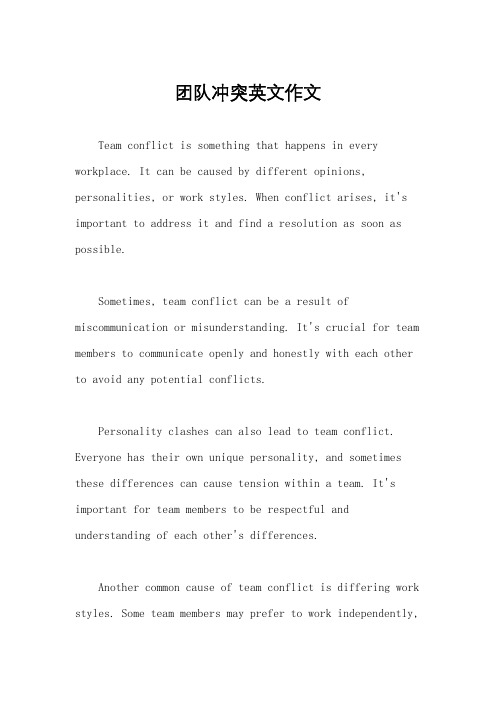
团队冲突英文作文Team conflict is something that happens in every workplace. It can be caused by different opinions, personalities, or work styles. When conflict arises, it's important to address it and find a resolution as soon as possible.Sometimes, team conflict can be a result of miscommunication or misunderstanding. It's crucial for team members to communicate openly and honestly with each other to avoid any potential conflicts.Personality clashes can also lead to team conflict. Everyone has their own unique personality, and sometimes these differences can cause tension within a team. It's important for team members to be respectful and understanding of each other's differences.Another common cause of team conflict is differing work styles. Some team members may prefer to work independently,while others thrive in a collaborative environment. Finding a balance and understanding each other's work styles is key to avoiding conflict.When conflict arises, it's important for team members to address it in a respectful and professional manner. This means actively listening to each other's perspectives and working together to find a solution that benefits theentire team.In some cases, it may be necessary to involve a mediator or team leader to help resolve the conflict. Having a neutral third party can help facilitate a productive discussion and find a resolution that everyone can agree on.Ultimately, addressing and resolving team conflict is essential for maintaining a positive and productive work environment. By communicating openly, being respectful of each other's differences, and working together to find solutions, teams can overcome conflict and continue working effectively together.。
与团队发生争执的英语作文
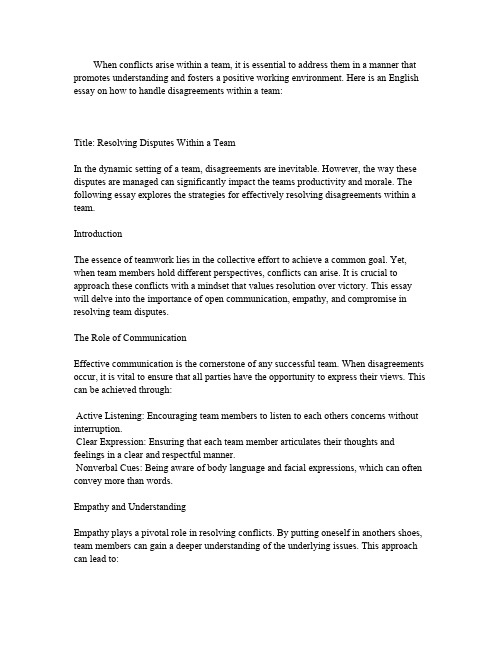
When conflicts arise within a team,it is essential to address them in a manner that promotes understanding and fosters a positive working environment.Here is an English essay on how to handle disagreements within a team:Title:Resolving Disputes Within a TeamIn the dynamic setting of a team,disagreements are inevitable.However,the way these disputes are managed can significantly impact the teams productivity and morale.The following essay explores the strategies for effectively resolving disagreements within a team.IntroductionThe essence of teamwork lies in the collective effort to achieve a common goal.Yet, when team members hold different perspectives,conflicts can arise.It is crucial to approach these conflicts with a mindset that values resolution over victory.This essay will delve into the importance of open communication,empathy,and compromise in resolving team disputes.The Role of CommunicationEffective communication is the cornerstone of any successful team.When disagreements occur,it is vital to ensure that all parties have the opportunity to express their views.This can be achieved through:Active Listening:Encouraging team members to listen to each others concerns without interruption.Clear Expression:Ensuring that each team member articulates their thoughts and feelings in a clear and respectful manner.Nonverbal Cues:Being aware of body language and facial expressions,which can often convey more than words.Empathy and UnderstandingEmpathy plays a pivotal role in resolving conflicts.By putting oneself in anothers shoes, team members can gain a deeper understanding of the underlying issues.This approach can lead to:Mutual Respect:Fostering an environment where all team members feel valued and respected.Shared Perspective:Encouraging a collective view that takes into account the diverse opinions within the team.The Art of CompromiseIn many cases,resolving a dispute requires a willingness to compromise.This involves:Identifying Common Ground:Finding areas where all team members can agree. Balancing Interests:Ensuring that the final decision takes into account the needs and concerns of all parties.Flexibility:Being open to adjusting ones stance in the interest of reaching a consensus. Conflict Resolution TechniquesThere are several techniques that can be employed to facilitate the resolution of team disputes:Mediation:Involving a neutral third party to help the team reach a mutually acceptable solution.Brainstorming:Encouraging creative problemsolving by generating a wide range of ideas.Structured Negotiation:Following a systematic process to address the points of disagreement.ConclusionIn conclusion,the ability to resolve disputes within a team is a critical skill for any professional.By prioritizing open communication,empathy,and compromise,teams can navigate through disagreements and emerge stronger and more cohesive.It is through these collaborative efforts that teams can achieve their goals and foster a positive working environment.This essay provides a comprehensive overview of the steps and strategies that can be employed to effectively manage and resolve disputes within a team.By adopting these practices,teams can ensure that their interactions are productive and that their collective efforts are directed towards achieving their objectives.。
处理团队冲突英文作文
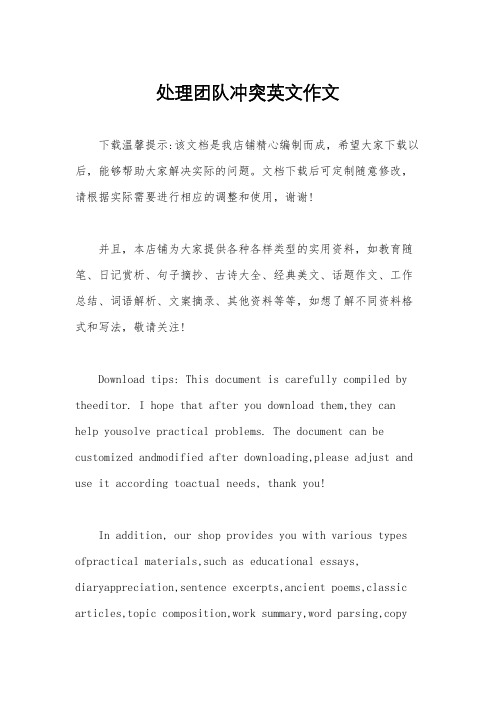
处理团队冲突英文作文下载温馨提示:该文档是我店铺精心编制而成,希望大家下载以后,能够帮助大家解决实际的问题。
文档下载后可定制随意修改,请根据实际需要进行相应的调整和使用,谢谢!并且,本店铺为大家提供各种各样类型的实用资料,如教育随笔、日记赏析、句子摘抄、古诗大全、经典美文、话题作文、工作总结、词语解析、文案摘录、其他资料等等,如想了解不同资料格式和写法,敬请关注!Download tips: This document is carefully compiled by theeditor. I hope that after you download them,they can help yousolve practical problems. The document can be customized andmodified after downloading,please adjust and use it according toactual needs, thank you!In addition, our shop provides you with various types ofpractical materials,such as educational essays, diaryappreciation,sentence excerpts,ancient poems,classic articles,topic composition,work summary,word parsing,copyexcerpts,other materials and so on,want to know different data formats andwriting methods,please pay attention!There are different opinions in the team. People may shout and get angry. That's really a mess.Sometimes people just don't listen to each other. They keep insisting on their own ideas. It's hard to make them change.But we need to find a way to solve it. Maybe we can have a calm talk and try to understand each other better.Or we can take a break and come back to it later. That might help.We can also ask for an outside person to help. They can give a fresh perspective.Everyone should be willing to compromise a little.That's important.。
冲突英语作文职场
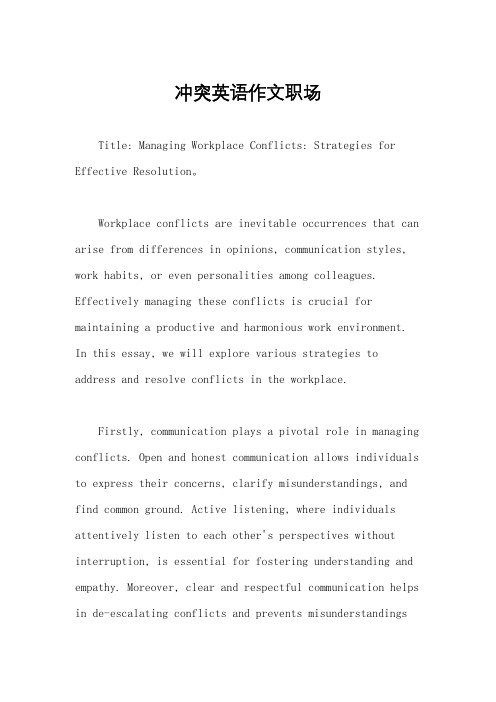
冲突英语作文职场Title: Managing Workplace Conflicts: Strategies for Effective Resolution。
Workplace conflicts are inevitable occurrences that can arise from differences in opinions, communication styles, work habits, or even personalities among colleagues. Effectively managing these conflicts is crucial for maintaining a productive and harmonious work environment. In this essay, we will explore various strategies to address and resolve conflicts in the workplace.Firstly, communication plays a pivotal role in managing conflicts. Open and honest communication allows individuals to express their concerns, clarify misunderstandings, and find common ground. Active listening, where individuals attentively listen to each other's perspectives without interruption, is essential for fostering understanding and empathy. Moreover, clear and respectful communication helps in de-escalating conflicts and prevents misunderstandingsfrom escalating into larger issues.Secondly, empathy and perspective-taking are essential in resolving workplace conflicts. Understanding the emotions and motivations behind the conflicting parties' actions can facilitate empathy and promote reconciliation. By putting oneself in the other person's shoes, individuals can gain insight into their perspective, which can lead to more constructive dialogue and solutions. Empathy fosters a sense of mutual respect and cooperation, making it easier to find compromises and move forward from conflicts.Thirdly, conflict resolution techniques such as negotiation and compromise are valuable skills in managing workplace conflicts. Negotiation involves finding mutually acceptable solutions through discussion and compromise. It requires identifying common goals and interests while being willing to make concessions to reach a resolution. Compromise, on the other hand, entails finding middle ground where both parties make concessions to meet each other's needs partially. These techniques promote collaboration and allow conflicting parties to find win-winsolutions that address their concerns effectively.Additionally, it is essential to involve a neutralthird party, such as a mediator or supervisor, in resolving conflicts when direct communication and negotiation fail to yield results. Mediators facilitate constructive dialogue between conflicting parties, helping them explore alternative perspectives and find common ground. Supervisors or managers can provide guidance and support in resolving conflicts, ensuring that resolutions align with organizational policies and objectives. Involving a neutral third party can bring fresh perspectives and facilitate more objective problem-solving.Moreover, creating a positive work culture that values diversity, inclusion, and respect can prevent conflicts from arising in the first place. Organizations can implement policies and practices that promote a culture of collaboration, transparency, and mutual respect among employees. Providing training on conflict management, communication skills, and cultural sensitivity can equip employees with the tools to navigate conflicts effectively.Additionally, fostering strong interpersonal relationships and team-building activities can strengthen bonds among colleagues, reducing the likelihood of conflicts and promoting a cohesive work environment.In conclusion, managing workplace conflicts requires a combination of effective communication, empathy, negotiation, and collaboration. By fostering open dialogue, understanding perspectives, and seeking mutually beneficial solutions, conflicts can be resolved constructively, fostering a positive and productive work environment. Additionally, creating a supportive organizational culture that values diversity and respect can prevent conflicts and promote harmony among employees. By employing these strategies, organizations can effectively manage conflicts and cultivate a culture of cooperation and mutual respect in the workplace.。
- 1、下载文档前请自行甄别文档内容的完整性,平台不提供额外的编辑、内容补充、找答案等附加服务。
- 2、"仅部分预览"的文档,不可在线预览部分如存在完整性等问题,可反馈申请退款(可完整预览的文档不适用该条件!)。
- 3、如文档侵犯您的权益,请联系客服反馈,我们会尽快为您处理(人工客服工作时间:9:00-18:30)。
TEAMWORK & TEAM-BUILDING ELEMENTS
HIDDEN AGENDA ISSUES
❖ Hidden agendas:
Comprised of attitudes and feelings that an individual brings to the group. Hidden agendas represent what an individual or group wants, instead of what they say they want.
4. Its work is consistently superior in both quality and quantity.
TEAMWORK & TEAM-BUILDING ELEMENTS
5. Problems and conflicts within the team are addressed quickly and professionally.
deliberately formed by management for the purpose of attaining company goals.
CHARACTERISTICS OF GROUPS
❖ Norms:
A generally agreed-on standard of behavior that every group member is expected to follow.
HOW TO HANDLE HIDDEN AGENDAS
1. Realize a hidden agenda is a natural part of the group process because people have their own goals and needs.
2. Recognize that a hidden agenda might be present when the group is having difficulty in reaching its goals.
WHY JOIN GROUPS?
❖ Affiliation (security, belonging, fripport) ❖ Identity (awareness of personal
identity) ❖ Goal accomplishment (the more
3. Decide how to bring the hidden agenda to light.
TEAMWORK & TEAM-BUILDING ELEMENTS
1. A team is composed of two or more persons in the company, usually from different departments.
brainpower, the better)
GROUPTHINK ISSUES
❖ Groupthink:
The tendency of highly cohesive groups to lose their critical evaluative abilities and out of a desire for unanimity, often overlook realistic, meaningful alternatives as attitudes are formed and decisions are made.
2. The members are competent and knowledgeable in the way they carry out their duties.
TEAMWORK & TEAM-BUILDING ELEMENTS
3. The team is constantly learning and growing; adapting itself to changing requirements and multiple goals.
❖ Conformity:
Group pressure forces its members to conform, or comply, with the norms established by the group.
CHARACTERISTICS OF GROUPS
❖ Cohesiveness:
An emotional closeness that exists among the group members, and its success depends on how well the group sticks together and acts as a single unit instead of as a group of individuals.
WHAT IS A GROUP?
❖ A group refers to two or more people who personally interact with each other in order to achieve a common goal.
TYPES OF GROUPS
❖ Informal groups:
arise spontaneously throughout all levels of the company and evolve out of employees’ needs for social interaction, friendship, and status.
❖ Formal groups:
